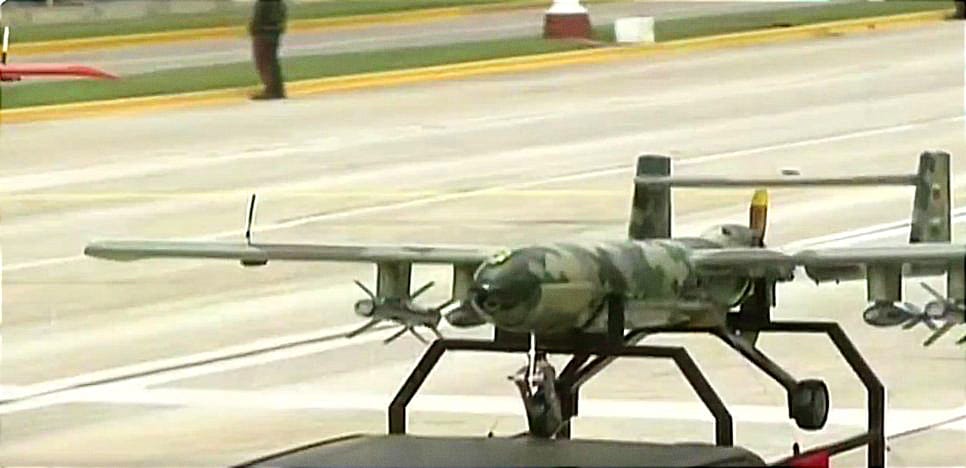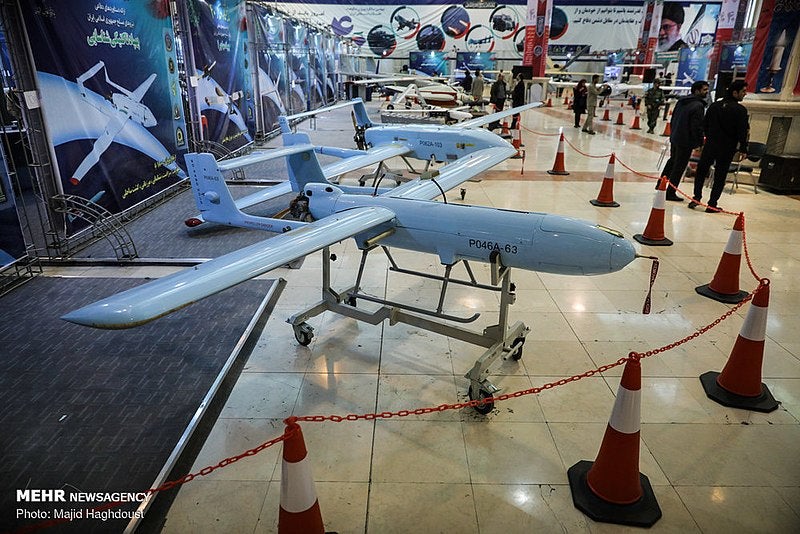Venezuela Showcases Iranian-Derrived ANSU 100 And ANSU 200 Drones for the First Time
Venezuela, a Latin American country in the grip of a political and economic crisis, commemorated its 211th anniversary of independence with a large military parade in Caracas. Venezuelan President Nicolas Maduro posted the footage of the military parade to his Twitter account.
At the military parade organized in celebration of Independence Day, Venezuela’s ANSU-100 and ANSU-200 type drones were on exhibit for the first time, in addition to more than 20,000 soldiers, artillery, and armored units. The ANSU-100, which was shown in the footage sporting the pixelated camouflage paint also employed on the T-27 Tucano trainer aircraft of the Venezuelan Air Force, was seen to be armed with at least two distinct types of munition at four different attachment points beneath its two wings. It is clear that the munitions shown in the footage included an air to ground missile (AGM) and a type of gravity bomb. Additionally, the footage showed that, in contrast to the Mohajer-2, the drone has three additional landing points and a non-retractable wheel chassis that enables takeoff from unpaved runways.

The Antonio José de Sucre-100 (ANSU-100) type drones are essentially a modernized, and armed version of the Mohajer-2 type UAVs that Iran supplied to Venezuela in 2007. The Venezuelan National Aviation Company (EANSA) developed the ANSU-100 drones, with Iran’s assistance as part of the ARPA program, while the National Bolivarian Armed Forces (FANB) of Venezuela oversees production and assembly. The ANSU-100, like most Iranian drones, has a body made of composite material. The drone with anti-tank and anti-personnel capabilities can also be used for observation, reconnaissance, and attack. Although the technical details of the ANSU-100 have not yet been made public, it is likely that the drone will have a range of 150 km, a cruise speed of 180 km/h, and a flight time of 6 hours assuming that the upgrades are on par with the Mohajer-2N standard, which is the most advanced variant of the Mohajer-2 UAV.

Additionally, Venezuela debuted the ANSU-200, a flying wing-design drone that it is still developing. The ANSU-200, which in the footage looks to be painted in the same camouflage pattern as the ANSU-100. It appears to have been based on the Iranian Shahed 171 Simorgh type drones with stealth flying wing designs. Iran developed the Shahed 171 Simorgh type drones through reverse engineering studies on the US drone RQ-170, which it shot down in 2011. Apart from a few open-source reports, little is known about the Antonio José de Sucre-200 (ANSU-200). The shared footage also provides no useful information about the drone. We do know that it was developed by the Venezuelan National Aviation Company (EANSA) as part of Iran’s technology transfer to Venezuela and that its body is made of composite material. Furthermore, the ANSU-200 will have capabilities such as intelligence, surveillance, search and reconnaissance (ISR), unmanned aerial vehicle hunting, and suppression of enemy air defense, according to the parade’s official narrator.
Another Iranian-origin system displayed at the Independence Day military parade was the Fadjr-1 multiple rocket launcher system, which the Venezuelan Ground Forces and Navy purchased from Iran some time ago. In the footage, it was seen that the Fadjr-1 multiple rocket launcher system was integrated into the Tiuna type 4×4 tactical vehicles of the Venezuelan army and the Damen Interceptor 1102 Orinoco class gunboats.
The imagery from the parade shows that, despite its claims, the country is still not producing its own military products, but rather combining what it already has and adapting it to the needs of the Venezuelan Armed Forces. Furthermore, the military parade demonstrates that the United States’ policies and sanctions against both countries were ineffective in preventing the military convergence of the Nicolas Maduro and Ebrahim Raisi regimes.
